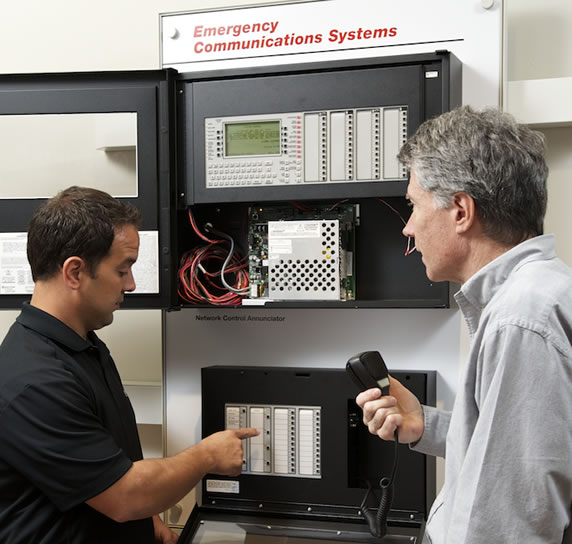 When the fire alarm sounds, what do you do? An advantage of voice evacuation and emergency communication systems (ECS) is that they provide a high-rise building’s occupants specific and detailed instructions on what to do. In case of fire or other emergency, the best course of action might be to evacuate the building – or it might be just the opposite, to “shelter-in-place” and await further instructions.
When the fire alarm sounds, what do you do? An advantage of voice evacuation and emergency communication systems (ECS) is that they provide a high-rise building’s occupants specific and detailed instructions on what to do. In case of fire or other emergency, the best course of action might be to evacuate the building – or it might be just the opposite, to “shelter-in-place” and await further instructions.
Defining Voice Communication Systems
A fire alarm voice evacuation system typically plays automated, prerecorded voice messages when a fire is detected. The systems can be configured to provide instructions geared to a person’s location in the building, in effect instructing people to evacuate the floor where there is a fire while instructing others to remain in safety where they are. Emptying a high-rise building all at once is impractical and could easily slow the evacuation of those closest to the fire.
Local jurisdictions have specific requirements about fire alarm voice evacuation systems, based on the National Fire Alarm and Signaling Code (NFPA 72) and/or the International Building Code (IBC), which requires high-rise buildings to have a voice evacuation system that sounds a tone followed by evacuation instructions.
NFPA 72 also includes requirements for ECS to warn of threats in addition to fire, such as weather emergencies, terrorist events, biological, chemical and nuclear emergencies, to name a few. However, NFPA 72 has changed over the years, and not every jurisdiction’s requirements are up-to-date with the latest editions of NFPA 72 – some may still be using versions from as far back as the 1990s.
Emergency communication systems are a broader category that includes both voice-based messaging and additional modes of communication such as email, SMS text messaging, pop-up messages on a computer screen or mobile device, LED signage, etc. Emergency communication systems are also known as mass notification systems (MNS), a term that originated in the military and has crossed over into usage with commercial systems too.
A significant change made within the last two editions of NFPA 72 (versions 2010 and 2013) is to allow an automated fire alarm message to be overridden by the building’s ECS voice messages, broadcasting emergency alerts. The ability to override can be helpful, for example, if someone with harmful intent were to initiate a fire alarm to cause confusion or an unnecessary evacuation.
 New Voice Evac Options
New Voice Evac Options
Newer fire alarm voice evacuation systems provide numerous audio zones and multiple channels for various alert messages. For example, an evacuation message could be directed to the floor where a fire is underway, and also to the floor above and below the fire. The rest of the building might get a message to await further instructions, and the stairwells of the building might receive a third message.
Even existing, older fire alarm systems can be integrated with voice evacuation by hard-wiring to a “side-car” audio system. Depending on the size of the building, it might instead be cost-effective to replace the older system with a newer fire alarm system that provides both fire protection and voice evacuation capabilities.
Various emergency communication systems may operate separate from a building’s fire alarm system. However, adding emergency notification functionality to a fire alarm system enables the ECS to leverage the code-driven requirements of fire alarm systems. For example, fire alarm systems are completely supervised and all are required to provide standby power by means of back-up battery power and/or emergency generator power. The system “knows” and reports if there is a break in a wire or other system problem. Backup power may require a system be able to function 24 or 60 hours in standby mode and 15 minutes in alarm mode, for example, even in the case of an AC electricity failure. This level of assurance carries over to any connected voice evacuation and emergency communication systems.
Recent tragedies have led to the entrance of multiple suppliers into the voice evacuation/ emergency communication arena. Buyers should conduct careful analysis of their facility and its occupants prior to making any purchasing decisions.
Choosing the Right ECS
Before implementing any type of ECS, a risk analysis should be performed to determine the various threats that could impact a high-rise facility. Building owners and managers, with help from other stakeholders like emergency responders, should create a long list of possible risks and then pare the list down to focus on the most likely and/or most potentially catastrophic possibilities. Obviously, a facility cannot protect against or mitigate the impact of every possible risk. Prioritizing events can direct where limited resources should best be utilized, including choosing the most appropriate emergency communication systems for your facility.
The ECS design should also consider areas outside a high-rise building, such as parking areas, garages and other outdoor areas. Sometimes a “giant outdoor voice” – involving a speaker system that is audible in affected areas – can provide the most effective communication in outdoor areas.
For additional guidance, building owners should look to the local authority having jurisdiction (AHJ), a consulting engineer or a fire installation company, whose engineering teams can offer various solutions to help direct the right course.
Dan Corbett
Dan Corbett is the product manager for Notifier by Honeywell.

